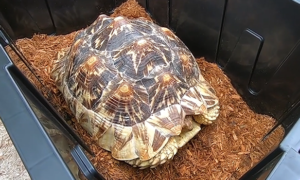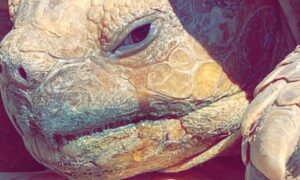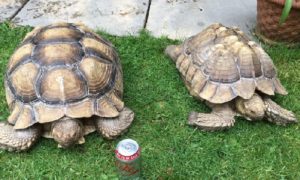Pyramiding in sulcata tortoises is rare in wild sulcatas. But in captivity, we see tortoises with bumpy shells frequently.
Pyramiding can be caused by a number of factors. No one factor is always the cause. In some cases, pyramiding can be caused by genetics or poor breeding, but most often, pyramiding in sulcata tortoises is caused by diet or housing.
And unfortunately, pyramiding cannot be reversed once it starts to happen. All you can do is try to correct the cause.
What is Pyramiding?
Pyramiding affects the scutes on the carapace, the top of the shell. Basically, as the tortoise grows, the growth lines become abnormal, causing pyramids to grow. Essentially, instead of growing flat, the growth is upward.
Pyramiding most often occurs in the vertebral scutes down the center of the shell. But, the costal scutes, along the sides, can also be affected.
The signs of pyramiding can vary from mild to very disfiguring. The worse the pyramiding, the more likely the tortoise’s mobility and overall health will be affected.
Incorrect Housing Causes Pyramiding
In more recent times, it’s thought that a dry environment is the biggest cause of pyramiding in sulcata tortoises.
Without proper hydration and humidity, sulcata tortoises can begin to pyramid as they grow. Humidity is pivotal for baby sulcatas. The humidity should be around 80%.
In the wild, sulcata eggs begin to hatch in the rainy season. Baby sulcatas will come out of the nest to graze and sun bathe, but they will retreat to a very humid burrow to keep safe.
It’s important to maintain a humid enclosure, especially while your baby sulcata is inside.

Enclosure Size Can Cause Pyramiding
Along with poor environment, if the enclosure is too small, the tortoise will not have enough room move and walk around. A sedentary lifestyle can cause the muscles and bones to weaken, predisposing the tortoise to abnormalities. Since the tortoise shell is a part of the skeletonal system, it can become weakened along with weak bones.
Improper Diet Causes Pyramiding
In the beginning, it was thought that poor diet was the sole cause of pyramiding in sulcata tortoises. There are a few dietary causes of pyramiding.
- Overfeeding
- Too much protein
- Too much fat
- Imbalance of calcium and phosphorus
The key to a proper diet is variety, grasses and weeds. Sulcatas need a high fiber diet. Avoid feeding too much of any one item, except grass and hay. A sulcata diet should be primarily grass and hay.
Only feed darker greens like, kale, collard greens, turnip greens and mustard greens, as a part of a varied diet. Limit them when possible. These foods are high in oxalates, which can cause calcium absorption concerns, which can then cause an imbalance of nutrients.
Avoid feeding vegetables and fruits, especially to baby and young sulcata tortoises.
Lack of Vitamin D3 and Sunlight Can Cause Pyramiding
Sunlight is pivotal for a healthy tortoise. Sulcatas need need exposure to direct sunlight and UVB rays in order to synthesize vitamin D3 for proper calcium absorption. If they don’t have enough vitamin D3, their shell can become damaged.
If your tortoise cannot get outside because of one reason or another, you need to ensure that you are offering an indoor calcium supplement that includes vitamin D3. You also want to make sure that you are using a good artifical UVB source while the tortosie is inside.
Dehydration Causes Pyramiding
Sulcata tortoises need to be soaked in warm water to ensure that they are getting enough water. Water is the key to life and good health.
Soak baby sulcatas once a day. Soak sulcatas that are about 6-inches every other day. Larger sulcata tortoises can be soaked once or twice a week.
In addition to soaking, make sure to have water available in the enclosure at all times. Use a safe water bowl that is easy to get in and out of.
Over time, dehydrated tortoises can begin to pyramid.





